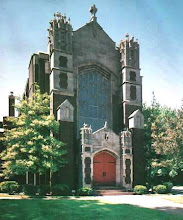Several times on the blog we've commented on the fact that so many of our favorite hymns were originally composed for children. It's an easy and dangerous trap to fall into nostalgia for a golden age, but we have to keep a broader picture of history when we look back. On my trip to Minnesota I picked up several boxes of old hymnals, from 50 to 100 years old and more. The quality of the music and the lyrics varies widely. To believe otherwise is to imagine that every big band sounded just like a Glenn Miller recording. Only the great hymns have survived to be reprinted in modern hymnals.
Furthermore, many of the hymnals for "children" in my collection are actually hymnals for families and schools. They're meant to be sung as part of instruction in faith for people of all ages. That's been the purpose of hymns since the times of Martin Luther (and last Sunday we sang one of his great hymns, "Salvation Unto Us Has Come").
We should also recall that 19th century education rarely extended to high school, much less college. Adolesence is a modern phenomenon, so that "children's music" would hardly be necessary in an age when adulthood came even earlier.
Related to that, we have also seen changes in our understanding and tastes in art, architecture, and literature. How many of us can "read" and comprehend the stained glass windows in our own church? How many schools still teach the same canon of literature and language that our grandparents learned? Again, it's easy to sound like a cantankerous old man, but I recognize that computers alone represent a massive skill set and level of learning that students today have. So many things have changed, and our emphasis in many areas of life have shifted.
In many ways, our hymnals (and obviously to a greater extent the Bible itself) represent a constant, unchanging set of instruction and belief. They're a great treasure, and it is our privilege to keep those tunes and texts alive today.
Wednesday, June 16, 2010
Subscribe to:
Post Comments (Atom)


No comments:
Post a Comment